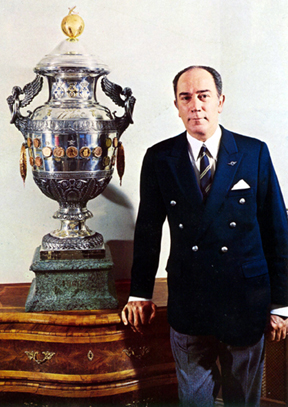Jose Louis de Aresti Aguirre, widely known within the aerobatic community and member of the International Aerobatic Club (IAC) Hall of Fame, passed away on November 18 in Madrid, Spain at the age of 84.
|
Aresti was most widely known for his work in developing the aerocryptographic system, or shorthand, for recording aerobatic maneuvers, more commonly known as the “Sistema Aresti” or Aresti System. His aerobatic figure diagrams allowed internationally competing pilots to communicate, even when they did not speak the same language. The Aresti System is accepted worldwide as the system of drawing aerobatic figures. The coveted Aresti Cup is awarded to the overall world aerobatic champion at the World Aerobatic Championships. Aresti donated the silver and gold-encrusted trophy to the Fėdėration Aėronautique Internationale (FAI) in 1964, a replica of which is on display in the aerobatic wing of the EAA AirVenture Museum in Oshkosh, Wisconsin. “Aresti’s contributions to the sport of aerobatics were singular and were recognized by IAC when we inducted him into the International Aerobatics Hall of Fame in 1987,” said Michael Heuer, President of FAI’s Aerobatics Commission (CIVA) and an IAC director. “He truly was a legend in our sport and his name synonymous with the figures we use in competition. We express our condolences to the family on behalf of all of air sports.” |
|
At his 1987 IAC Hall of Fame induction, EAA President Tom Poberezny noted, “No one has done as much to bring a professional standard to judging, to recording, to simplifying the process of building and scoring aerobatic sequences. No one in the world has touched the lives of as many aerobatic pilots, judges and administrators as Aresti. It’s amazing when you think of it. Looking at the sport worldwide, we take off for the aerobatic box in many different types of aircraft, speaking different languages, wearing different clothes and uniforms, but every one of us leaves a little space on our instrument panel for the one thing we all use in common, the aerocryptographic language of Jose’ Luis Aresti.”
>He was born in Bilbao, Spain in 1919, began flying in the 1930s, and was an aerobatic flight instructor in the Spanish Air Force during World War II. Aresti provided the country’s first aerobatic flight manual and founded several pilot training schools after the war when he also became active on the European airshow circuit flying the Bucker Jungmeister.
Aresti became very active in CIVA’s early years as the Delegate of Spain, which would host the 1964 WAC at Bilbao. His work on an aerobatic catalogue started previous to that and it was in 1964 that the "Aresti Aerocryptographic System" was introduced and approved by CIVA. At the time, some 3,000 maneuvers were catalogued along with difficulty coefficients (called K-factors today), which was used until 1987. He was highly instrumental in obtaining government support for aerobatic flying in Spain, which led to very successful aerobatic teams from Spain at the WAC.
Aresti served as CIVA President in 1968-1969 and was its President of Honour up until his death. He was awarded the FAI Silver and Gold Medals for his work on the catalogue. He brought a professional standard to the cataloguing of aerobatic figures and provided “shorthand” that was used internationally for decades, thereby touching the lives of thousands of aerobatic pilots throughout the world.


